Junbin Xiao
EgoExo-Con: Exploring View-Invariant Video Temporal Understanding
Oct 30, 2025Abstract:Can Video-LLMs achieve consistent temporal understanding when videos capture the same event from different viewpoints? To study this, we introduce EgoExo-Con (Consistency), a benchmark of comprehensively synchronized egocentric and exocentric video pairs with human-refined queries in natural language. EgoExo-Con emphasizes two temporal understanding tasks: Temporal Verification and Temporal Grounding. It evaluates not only correctness but consistency across viewpoints. Our analysis reveals two critical limitations of existing Video-LLMs: (1) models often fail to maintain consistency, with results far worse than their single-view performances. (2) When naively finetuned with synchronized videos of both viewpoints, the models show improved consistency but often underperform those trained on a single view. For improvements, we propose View-GRPO, a novel reinforcement learning framework that effectively strengthens view-specific temporal reasoning while encouraging consistent comprehension across viewpoints. Our method demonstrates its superiority over naive SFT and GRPO, especially for improving cross-view consistency. All resources will be made publicly available.
Object-Level Verbalized Confidence Calibration in Vision-Language Models via Semantic Perturbation
Apr 21, 2025



Abstract:Vision-language models (VLMs) excel in various multimodal tasks but frequently suffer from poor calibration, resulting in misalignment between their verbalized confidence and response correctness. This miscalibration undermines user trust, especially when models confidently provide incorrect or fabricated information. In this work, we propose a novel Confidence Calibration through Semantic Perturbation (CSP) framework to improve the calibration of verbalized confidence for VLMs in response to object-centric queries. We first introduce a perturbed dataset where Gaussian noise is applied to the key object regions to simulate visual uncertainty at different confidence levels, establishing an explicit mapping between visual ambiguity and confidence levels. We further enhance calibration through a two-stage training process combining supervised fine-tuning on the perturbed dataset with subsequent preference optimization. Extensive experiments on popular benchmarks demonstrate that our method significantly improves the alignment between verbalized confidence and response correctness while maintaining or enhancing overall task performance. These results highlight the potential of semantic perturbation as a practical tool for improving the reliability and interpretability of VLMs.
Visual Intention Grounding for Egocentric Assistants
Apr 18, 2025Abstract:Visual grounding associates textual descriptions with objects in an image. Conventional methods target third-person image inputs and named object queries. In applications such as AI assistants, the perspective shifts -- inputs are egocentric, and objects may be referred to implicitly through needs and intentions. To bridge this gap, we introduce EgoIntention, the first dataset for egocentric visual intention grounding. EgoIntention challenges multimodal LLMs to 1) understand and ignore unintended contextual objects and 2) reason about uncommon object functionalities. Benchmark results show that current models misidentify context objects and lack affordance understanding in egocentric views. We also propose Reason-to-Ground (RoG) instruction tuning; it enables hybrid training with normal descriptions and egocentric intentions with a chained intention reasoning and object grounding mechanism. RoG significantly outperforms naive finetuning and hybrid training on EgoIntention, while maintaining or slightly improving naive description grounding. This advancement enables unified visual grounding for egocentric and exocentric visual inputs while handling explicit object queries and implicit human intentions.
EgoBlind: Towards Egocentric Visual Assistance for the Blind People
Mar 11, 2025Abstract:We present EgoBlind, the first egocentric VideoQA dataset collected from blind individuals to evaluate the assistive capabilities of contemporary multimodal large language models (MLLMs). EgoBlind comprises 1,210 videos that record the daily lives of real blind users from a first-person perspective. It also features 4,927 questions directly posed or generated and verified by blind individuals to reflect their needs for visual assistance under various scenarios. We provide each question with an average of 3 reference answers to alleviate subjective evaluation. Using EgoBlind, we comprehensively evaluate 15 leading MLLMs and find that all models struggle, with the best performers achieving accuracy around 56\%, far behind human performance of 87.4\%. To guide future advancements, we identify and summarize major limitations of existing MLLMs in egocentric visual assistance for the blind and provide heuristic suggestions for improvement. With these efforts, we hope EgoBlind can serve as a valuable foundation for developing more effective AI assistants to enhance the independence of the blind individuals' lives.
EgoTextVQA: Towards Egocentric Scene-Text Aware Video Question Answering
Feb 11, 2025Abstract:We introduce EgoTextVQA, a novel and rigorously constructed benchmark for egocentric QA assistance involving scene text. EgoTextVQA contains 1.5K ego-view videos and 7K scene-text aware questions that reflect real-user needs in outdoor driving and indoor house-keeping activities. The questions are designed to elicit identification and reasoning on scene text in an egocentric and dynamic environment. With EgoTextVQA, we comprehensively evaluate 10 prominent multimodal large language models. Currently, all models struggle, and the best results (Gemini 1.5 Pro) are around 33% accuracy, highlighting the severe deficiency of these techniques in egocentric QA assistance. Our further investigations suggest that precise temporal grounding and multi-frame reasoning, along with high resolution and auxiliary scene-text inputs, are key for better performance. With thorough analyses and heuristic suggestions, we hope EgoTextVQA can serve as a solid testbed for research in egocentric scene-text QA assistance.
On the Consistency of Video Large Language Models in Temporal Comprehension
Nov 20, 2024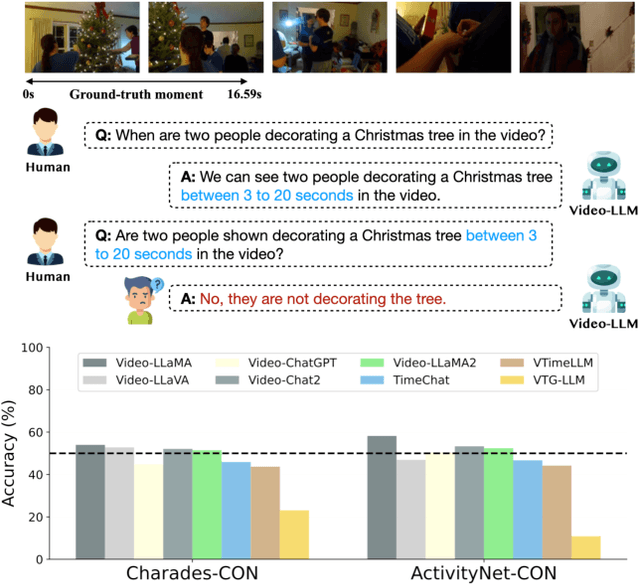

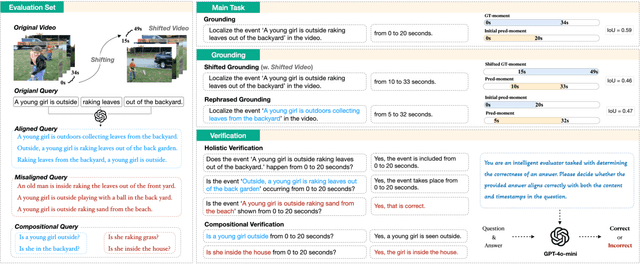

Abstract:Video large language models (Video-LLMs) can temporally ground language queries and retrieve video moments. Yet, such temporal comprehension capabilities are neither well-studied nor understood. So we conduct a study on prediction consistency -- a key indicator for robustness and trustworthiness of temporal grounding. After the model identifies an initial moment within the video content, we apply a series of probes to check if the model's responses align with this initial grounding as an indicator of reliable comprehension. Our results reveal that current Video-LLMs are sensitive to variations in video contents, language queries, and task settings, unveiling severe deficiencies in maintaining consistency. We further explore common prompting and instruction-tuning methods as potential solutions, but find that their improvements are often unstable. To that end, we propose event temporal verification tuning that explicitly accounts for consistency, and demonstrate significant improvements for both grounding and consistency. Our data and code will be available at https://github.com/minjoong507/Consistency-of-Video-LLM.
Scene-Text Grounding for Text-Based Video Question Answering
Sep 22, 2024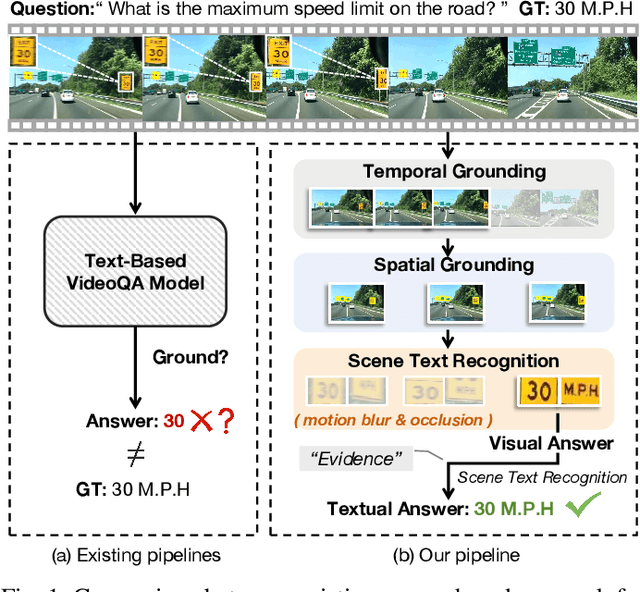
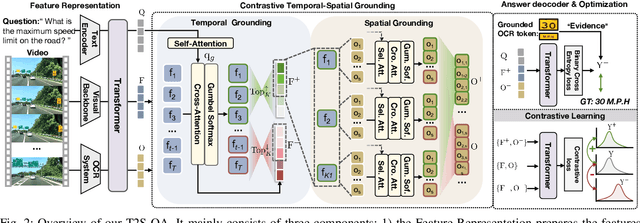
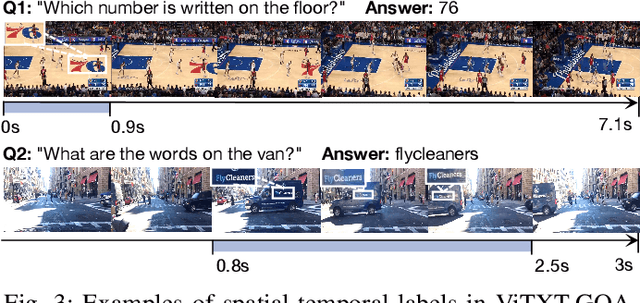
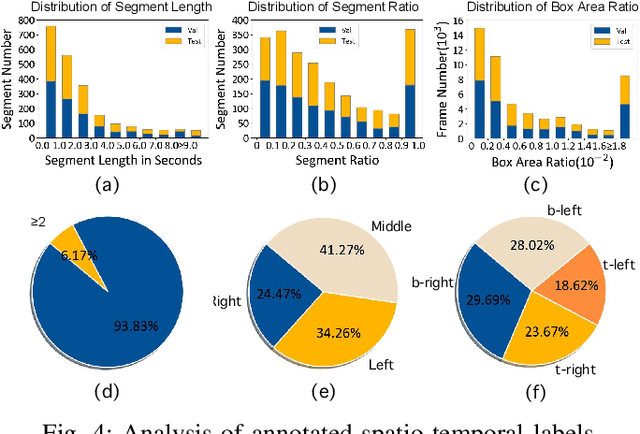
Abstract:Existing efforts in text-based video question answering (TextVideoQA) are criticized for their opaque decisionmaking and heavy reliance on scene-text recognition. In this paper, we propose to study Grounded TextVideoQA by forcing models to answer questions and spatio-temporally localize the relevant scene-text regions, thus decoupling QA from scenetext recognition and promoting research towards interpretable QA. The task has three-fold significance. First, it encourages scene-text evidence versus other short-cuts for answer predictions. Second, it directly accepts scene-text regions as visual answers, thus circumventing the problem of ineffective answer evaluation by stringent string matching. Third, it isolates the challenges inherited in VideoQA and scene-text recognition. This enables the diagnosis of the root causes for failure predictions, e.g., wrong QA or wrong scene-text recognition? To achieve Grounded TextVideoQA, we propose the T2S-QA model that highlights a disentangled temporal-to-spatial contrastive learning strategy for weakly-supervised scene-text grounding and grounded TextVideoQA. To facilitate evaluation, we construct a new dataset ViTXT-GQA which features 52K scene-text bounding boxes within 2.2K temporal segments related to 2K questions and 729 videos. With ViTXT-GQA, we perform extensive experiments and demonstrate the severe limitations of existing techniques in Grounded TextVideoQA. While T2S-QA achieves superior results, the large performance gap with human leaves ample space for improvement. Our further analysis of oracle scene-text inputs posits that the major challenge is scene-text recognition. To advance the research of Grounded TextVideoQA, our dataset and code are at \url{https://github.com/zhousheng97/ViTXT-GQA.git}
Question-Answering Dense Video Events
Sep 10, 2024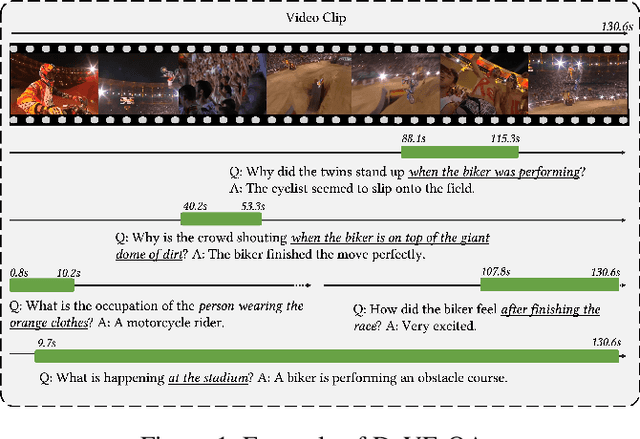

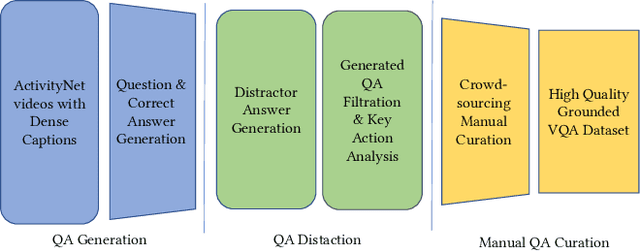
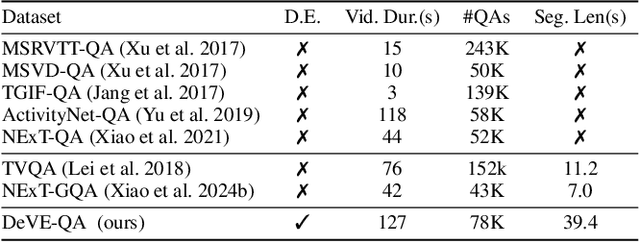
Abstract:Multimodal Large Language Models (MLLMs) have shown excellent performance in question-answering of single-event videos. In this paper, we present question-answering dense video events, a novel task that requires answering and grounding the dense-event questions in long videos, thus challenging MLLMs to faithfully comprehend and reason about multiple events occurring over extended time periods. To facilitate the study, we construct DeVE-QA - a dataset featuring 78K questions about 26K events on 10.6K long videos. We then benchmark and show that existing MLLMs excelling at single-event QA struggle to perform well in DeVE-QA. For improvement, we propose DeVi, a novel training-free MLLM approach that highlights a hierarchical captioning module, a temporal event memory module, and a self-consistency checking module to respectively detect, contextualize and memorize, and ground dense-events in long videos for question answering. Extensive experiments show that DeVi is superior at answering dense-event questions and grounding relevant video moments. Compared with existing MLLMs, it achieves a remarkable increase of 4.1 percent and 3.7 percent for G(round)QA accuracy on DeVE-QA and NExT-GQA respectively.
Towards Analyzing and Mitigating Sycophancy in Large Vision-Language Models
Aug 21, 2024



Abstract:Large Vision-Language Models (LVLMs) have shown significant capability in vision-language understanding. However, one critical issue that persists in these models is sycophancy, which means models are unduly influenced by leading or deceptive prompts, resulting in biased outputs and hallucinations. Despite the progress in LVLMs, evaluating and mitigating sycophancy is yet much under-explored. In this work, we fill this gap by systematically analyzing sycophancy on various VL benchmarks with curated leading queries and further proposing a text contrastive decoding method for mitigation. While the specific sycophantic behavior varies significantly among models, our analysis reveals the severe deficiency of all LVLMs in resilience of sycophancy across various tasks. For improvement, we propose Leading Query Contrastive Decoding (LQCD), a model-agnostic method focusing on calibrating the LVLMs' over-reliance on leading cues by identifying and suppressing the probabilities of sycophancy tokens at the decoding stage. Extensive experiments show that LQCD effectively mitigate sycophancy, outperforming both prompt engineering methods and common methods for hallucination mitigation. We further demonstrate that LQCD does not hurt but even slightly improves LVLMs' responses to neutral queries, suggesting it being a more effective strategy for general-purpose decoding but not limited to sycophancy.
VideoQA in the Era of LLMs: An Empirical Study
Aug 08, 2024



Abstract:Video Large Language Models (Video-LLMs) are flourishing and has advanced many video-language tasks. As a golden testbed, Video Question Answering (VideoQA) plays pivotal role in Video-LLM developing. This work conducts a timely and comprehensive study of Video-LLMs' behavior in VideoQA, aiming to elucidate their success and failure modes, and provide insights towards more human-like video understanding and question answering. Our analyses demonstrate that Video-LLMs excel in VideoQA; they can correlate contextual cues and generate plausible responses to questions about varied video contents. However, models falter in handling video temporality, both in reasoning about temporal content ordering and grounding QA-relevant temporal moments. Moreover, the models behave unintuitively - they are unresponsive to adversarial video perturbations while being sensitive to simple variations of candidate answers and questions. Also, they do not necessarily generalize better. The findings demonstrate Video-LLMs' QA capability in standard condition yet highlight their severe deficiency in robustness and interpretability, suggesting the urgent need on rationales in Video-LLM developing.
 Add to Chrome
Add to Chrome Add to Firefox
Add to Firefox Add to Edge
Add to Edge